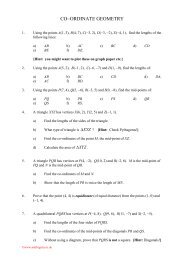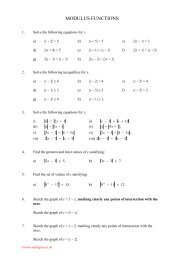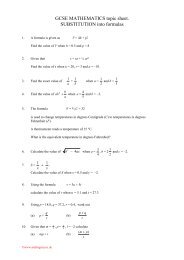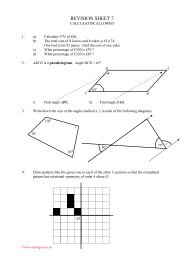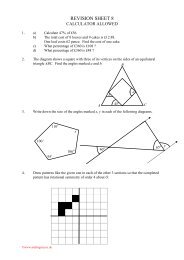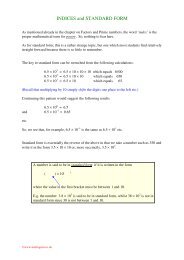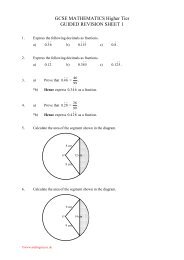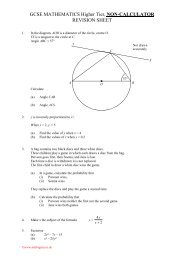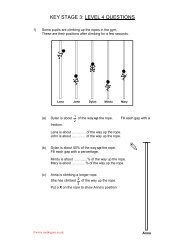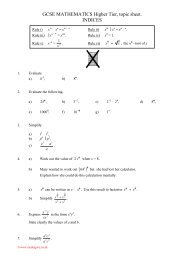GCSE MATHEMATICS Higher Tier, topic sheet. PROBABILITY
GCSE MATHEMATICS Higher Tier, topic sheet. PROBABILITY
GCSE MATHEMATICS Higher Tier, topic sheet. PROBABILITY
You also want an ePaper? Increase the reach of your titles
YUMPU automatically turns print PDFs into web optimized ePapers that Google loves.
<strong>GCSE</strong> <strong>MATHEMATICS</strong> <strong>Higher</strong> <strong>Tier</strong>, <strong>topic</strong> <strong>sheet</strong>.<br />
<strong>PROBABILITY</strong><br />
1. The probability that Jenny will beat Gill at tennis is 3 5 .<br />
The probability that Jenny will beat Gill at both tennis and snooker is 1 4 .<br />
What is the probability that Jenny will beat Gill at snooker?<br />
2. In a village, 3 5<br />
of the pensioners have had a flu jab.<br />
If a pensioner has had the flu jab, the probability of catching flu is 1<br />
30 .<br />
If a pensioner has not had the flu jab, the probability of catching flu is 7<br />
10 .<br />
a) Calculate the probability that a pensioner, picked at random from this village,<br />
catches flu.<br />
b) A statistician calculated that 120 pensioners from this village are expected to catch<br />
flu. Calculate how many pensioners live in the village.<br />
3.<br />
4<br />
3<br />
1<br />
2<br />
2 3<br />
2<br />
5<br />
1<br />
1 2<br />
5<br />
5<br />
2<br />
The diagram shows two fair spinners. Both spinners are spun and the scores are added<br />
together. What is the probability that the sum of the scores is at least 5?<br />
4. A box contains 10 coloured discs numbered 1 to 10.<br />
The discs numbered 1 to 5 are red.<br />
The discs numbered 6 to 9 are blue.<br />
The disc numbered 10 is green.<br />
A disc is taken at random from the box and is not replaced.<br />
A second disc is then taken from the box.<br />
Calculate the probability that the two discs are the same colour and the numbers on them add<br />
to more than 8.<br />
www.mathsguru.co.uk
5. Jill is playing a game with a set of five discs.<br />
Three of the discs are numbered 1 and the other two are numbered 2.<br />
1 1 1 2 2<br />
The discs are placed in a bag.<br />
Jill draws a disc from the bag and looks at its number.<br />
If the first disc drawn is numbered 1, she takes one more disc from the bag.<br />
Her score is the total of the three discs left in the bag.<br />
If the first disc drawn is numbered 2, she takes two more discs from the bag.<br />
Her score is the total of the two discs left in the bag.<br />
a) Complete the table below.<br />
First disc drawn Further disc(s) taken Discs left in the bag Score<br />
b) Calculate the probability that Jill gets a score of 3.<br />
6. Mick is a striker for his local football team.<br />
The probabilities of Mick scoring 0, 1, 2 or 3 goals in any game are shown in the table.<br />
Number of goals 0 1 2 3<br />
Probability 0.4 0.3 0.2 0.1<br />
Mick’s performance in any game is independent of any other game.<br />
a) Calculate the probability that Mick scores in each of three consecutive games.<br />
b) Calculate the probability that Mick scores a total of 8 or more goals in three<br />
consecutive games.<br />
7. A bucket contains tennis balls which are identical apart from their colour.<br />
There are 5 yellow balls, 3 white balls and 2 green balls in the bucket.<br />
Martina chooses two of the balls at random and without replacement.<br />
What is the probability that the balls are the same colour.<br />
www.mathsguru.co.uk
SOLUTIONS / ANSWERS.<br />
1. Tennis Snooker<br />
Jenny<br />
wins<br />
= 1 4<br />
3<br />
5<br />
2<br />
5<br />
Jenny<br />
wins<br />
Gill<br />
wins<br />
Gill<br />
wins<br />
Jenny<br />
wins<br />
Gill<br />
wins<br />
Using the multiplication rule for probabilities, 1 4 = 3 5<br />
× P(Jill wins snooker).<br />
This means that P(Jill wins snooker) =<br />
2. This is a classic tree diagram question!<br />
1<br />
<br />
<br />
4<br />
<br />
3<br />
<br />
<br />
5<br />
<br />
= 5<br />
12 .<br />
1<br />
30<br />
Catches<br />
flu<br />
3<br />
5<br />
Had jab<br />
29<br />
30<br />
OK<br />
2<br />
5<br />
Not had<br />
jab<br />
7<br />
10<br />
Catches<br />
flu<br />
a)<br />
b)<br />
3<br />
5 × 1<br />
30 + 2 5 × 7<br />
10 = 3<br />
3<br />
10 .<br />
10<br />
3<br />
’s of pensioners catch flu.<br />
10<br />
This means that 3 ’s of pensioners = 120 pensioners,<br />
10<br />
1<br />
of pensioners = 120 ÷ 3 = 40<br />
10<br />
and thus there are 400 pensioners.<br />
OK<br />
www.mathsguru.co.uk
3. Best off ‘picturing’ a tree diagram which includes only the desired outcomes!<br />
left-hand spinner<br />
right-hand spinner<br />
1 5 = 1 6 × 3 8 = 3<br />
48<br />
2 5 = 2 6 × 3 8 = 6 48<br />
3 2 or 5 = 2 6 × 6 8 = 12<br />
48<br />
4 1 or 2 or 5 = 1 6 × 8 8 = 8 48<br />
Answer = 3 + 6 + 12 + 8<br />
48<br />
= 29<br />
48 .<br />
4. Best off ‘picturing’ a tree diagram which includes only the desired outcomes; namely the<br />
2 discs are the same colour and add to more than 8.<br />
first disc<br />
second disc<br />
4 5 = 1<br />
10 × 1 9 = 1<br />
90<br />
5 4 = 1<br />
10 × 1 9 = 1<br />
90<br />
6 any remaining (7, 8 or 9)<br />
1<br />
=<br />
10 × 3 9 = 3<br />
90<br />
7 any remaining (6, 8 or 9)<br />
1<br />
=<br />
10 × 3 9 = 3<br />
90<br />
8 any remaining (6, 7 or 9)<br />
1<br />
=<br />
10 × 3 9 = 3<br />
90<br />
9 any remaining (6, 7 or 8)<br />
1<br />
=<br />
10 × 3 9 = 3<br />
90<br />
Answer = 1 + 1 + 3 + 3 + 3 + 3<br />
90<br />
= 7 45 .<br />
5. a)<br />
First disc drawn Further disc(s) taken Discs left in the bag Score<br />
1 1 1, 2, 2 5<br />
1 2 1, 1, 2 4<br />
2 1, 1 1, 2 3<br />
2 1, 2 1, 1 2<br />
b) P(score = 3) = P(1 st is a 2 and the 2 nd disc is a 1 and the 3 rd disc is a 1)<br />
= 2 5 × 3 4 × 2 3<br />
{picture a tree diagram}<br />
= 12<br />
60 = 1 5 .<br />
www.mathsguru.co.uk
6. Again, this is a classic tree-diagram question. However, drawing the full tree would be a<br />
little unwieldy.<br />
a) 0.6 × 0.6 × 0.6 = 0.216.<br />
b) Rather than draw the entire tree-diagram, list out just the desired outcomes with the<br />
number of goals scored.<br />
first game second game third game<br />
2 3 3 = 0.2 × 0.1 × 0.1 = 0.002<br />
3 2 3 = 0.1 × 0.2 × 0.1 = 0.002<br />
3 3 2 = 0.1 × 0.1 × 0.2 = 0.002<br />
3 3 3 = 0.1 × 0.1 × 0.1 = 0.001<br />
Answer = 0.002 + 0.002 + 0.002 + 0.001 = 0.007.<br />
7. Draw the part of the tree-diagram which represents the two balls being of the same colour.<br />
Drawing the full tree will simply waste time!<br />
4<br />
9<br />
Y<br />
= 5 × 4 =<br />
20<br />
10 9 90<br />
5<br />
10<br />
2<br />
10<br />
3<br />
10<br />
Y<br />
W<br />
G<br />
2<br />
9<br />
W<br />
= 3 × 2 =<br />
6<br />
10 9 90<br />
1<br />
9<br />
G<br />
= 2 × 1 =<br />
2<br />
10 9 90<br />
Answer = 20 + 6 + 2<br />
90<br />
= 14<br />
45 .<br />
www.mathsguru.co.uk




